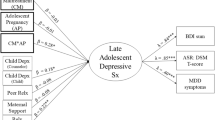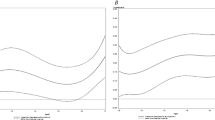Abstract
Unintended birth and mental health are major public health problems in the United States. To date, little research has examined the relationship between depressive symptoms and unintended births, and no research has examined this relationship among men. Data from the National Longitudinal Survey of Adolescent Health (N = 14,271) were used to examine the relationship between depressive symptoms among females and males in adolescence and unintended first birth in emerging adulthood. Respondents who reported higher levels of depressive symptoms in adolescence were more likely to report an unintended birth (OR 1.93, p < 0.001) compared with respondents who did not have children. They were also more likely to report an unintended birth compared with respondents who had an intended birth (OR 1.28, p < 0.05). The relationship between adolescent depressive symptoms and unintended birth remained significant, controlling for background variables, and it did not differ by gender. Adolescent depressive symptoms are associated with unintended birth in emerging adulthood. Thus, policies designed to treat depressive symptoms in adolescence may be effective in reducing unintended pregnancy among young adults.
Similar content being viewed by others
References
Maxson, P., & Miranda, M. L. (2011). Pregnancy intention, demographic differences, and psychosocial health. Journal of Women’s Health (Larchmt), 20(8), 1215–1223.
Mosher, W. D., Jones, J., & Abma, J. C. (2012). Intended and unintended births in the United States: 1982–2010. National Health Statistics Report, 55, 1–28.
D’Angelo, D., Gilbert, B., Rochat, R., Santelli, J., & Herold, J. (2004). Differences between mistimed and unwanted pregnancies among women who have live births. Perspectives on Sexual and Reproductive Health, 36(5), 192–197.
Grussu, P., Quatraro, R. M., & Nasta, M. T. (2005). Profile of mood states and parental attitudes in motherhood: Comparing women with planned and unplanned pregnancies. Birth, 32(2), 107–114.
Gazmararian, J. A., Adams, M. M., Saltzman, L. E., Johnson, C. H., Carol Bruce, F., Marks, J. S., et al. (1995). The relationship between pregnancy intendedness and physical violence in mothers of newborns. Obstetrics and Gynecology, 85(6), 1031–1038.
Barber, J. S., Axinn, W. G., & Thornton, A. (1999). Unwanted childbearing, health, and mother–child relationships. Journal of Health and Social Behavior, 40(3), 231–257.
Dye, T. D., Wojtowycz, M. A., Aubry, R. H., Quade, J., & Kilburn, H. (1997). Unintended pregnancy and breast-feeding behavior. American Journal of Public Health, 87(10), 1709–1711.
Sable, M., & Wilkinson, D. (2000). Impact of perceived stress, major life events and pregnancy attitudes on low birth weight. Family Planning Perspectives, 32(6), 288–294.
Logan, C., Holcombe, E., Manlove, J., & Ryan, S. (2007). The consequences of unintended childbearing: A white paper. Washington, DC: Child Trends.
Bennett, I. M., Culhane, J. F., McCollum, K. F., & Elo, I. T. (2006). Unintended rapid repeat pregnancy and low education status: Any role for depression and contraceptive use? American Journal of Obstetrics and Gynecology, 194, 749–754.
Lancaster, C. A., Gold, K. J., Flynn, H. A., Yoo, H., Marcus, S. M., & Davis, M. M. (2010). Risk factors for depressive symptoms during pregnancy: A systematic review. American Journal of Obstetrics and Gynecology, 202(1), 5–14.
Tenkku, L. E., Flick, L. H., Homan, S., Loveland Cook, C. A., Campbell, C., & McSweeney, M. (2009). Psychiatric disorders among low-income women and unintended pregnancies. Women’s Health Issues, 19(5), 313–324.
Trent, K., & Crowder, K. (1997). Adolescent birth intentions, social disadvantage, and behavioral outcomes. Journal of Marriage and the Family, 59(3), 523–535.
Kirby, D. (2002). Antecedents of adolescent initiation of sex, contraceptive use, and pregnancy. American Journal of Health Behavior, 26(6), 473–485.
Vicary, J., & Corneal, D. (2001). A comparison of young women’s psychosocial status based on age of their first childbirth. Family & Community Health, 24(2), 73–84.
Mollborn, S., & Morningstar, E. (2009). Investigating the relationship between teenage childbearing and psychological distress using longitudinal evidence. Journal of Health and Social Behavior, 50(3), 310–326.
Miller-Johnson, S., Winn, D. M., Coie, J., Mmaumary-Gremaud, A., Hyman, C., Terry, R., et al. (1999). Motherhood during the teen years: A developmental perspective on risk factors for childbearing. Development and Psychopathology, 11, 85–100.
Jaccard, J. (2009). Unlocking the contraceptive conundrum: Reducing unplanned pregnancy in emerging adulthood. Washington, DC: The National Campaign to Reduce Teen and Unplanned Pregnancy.
Lehrer, J. A., Shrier, L. A., Gortmaker, S., & Buka, S. (2006). Depressive symptoms as a longitudinal predictor of sexual risk behaviors among US middle and high school students. Pediatrics, 118(1), 189–200.
Fergusson, D., & Woodward, L. (2002). Mental health, educational, and social role outcomes of adolescents with depression. Archives of General Psychiatry, 59(3), 225–231.
Pine, D. S., Cohen, E., Cohen, P., & Brook, J. (1999). Adolescent depressive symptoms as predictors of adult depression: Moodiness or mood disorder? American Journal of Psychiatry, 156(1), 133–135.
Bearman, P., Jones, J., & Udry, J. R. (1997). The national longitudinal study of adolescent health: Research design. Chapel Hill, NC: Carolina Population Center.
Chantala, K., & Tabor, J. (2010). Strategies to perform a design-based analysis using the add health data. In UoNCaCH (Ed.). Chapel Hill, NC: Carolina Population Center.
Cheng, M. M. (2010). Relationship and fertility data: Wave IV. In Add health users conference, 2010. Chapel Hill, NC: University of North Carolina at Chapel Hill.
Blanchflower, D., & Oswald, A. (2008). Is well-being U-shaped over the life cycle? Social Science and Medicine, 66(8), 1733–1749.
Finer, L. B., & Henshaw, S. K. (2006). Disparities in rates of unintended pregnancy in the United States, 1994 and 2001. Perspectives on Sexual and Reproductive Health, 38(2), 90–96.
Radloff, L. S. (1991). The use of the Center for Epidemiologic Studies Depression Scale in adolescents and young adults. Journal of Youth and Adolescence, 20(2), 149–166.
Guzman, L., Wildsmith, E., Manlove, J., & Franzetta, K. (2010). Unintended births: Patterns by race and ethnicity and relationship type. Perspectives on Sexual and Reproductive Health, 42(3), 176–185.
Joyner, K., Peters, H. E., Hynes, K., Sikora, A., Taber, J. R., & Rendall, M. S. (2012). The quality of male fertility data in major U.S. surveys. Demography, 49(1), 101–124.
Montgomery, M. (1996). Comments on men, women, and unintended pregnancy. Population and Development Review, 22, 100–106.
Chewning, B., & Van Koningsveld, R. (1998). Predicting adolescents’ initiation of intercourse and contraceptive use. Journal of Applied Social Psychology, 28(14), 1245–1285.
Kowaleski-Jones, L., & Mott, F. L. (1998). Sex, contraception and childbearing among high-risk youth: Do different factors influence males and females? Family Planning Perspectives, 30(4), 163–169.
Jaycox, L. H., Stein, B. D., Paddock, S., Miles, J. N., Chandra, A., Meredith, L. S., et al. (2009). Impact of teen depression on academic, social, and physical functioning. Pediatrics, 124(4), e596–e605.
Harris, K. M., & Udry, J. R. (2013). National Longitudinal Study of Adolescent Health (Add Health), 1994–2008. ICPSR21600-v14. Chapel Hill, NC: Carolina Population Center, University of North Carolina-Chapel Hill/Ann Arbor, MI: Inter-university Consortium for Political and Social Research [distributors]. doi:10.3886/ICPSR21600.v14.
Acknowledgments
This project received funding and administrative support from the University of Colorado Population Center, which is funded by the Eunice Kennedy Shriver National Institute of Child Health and Human Development (Grant NICHD R21 HD051146). It uses data from Add Health, a program project directed by Kathleen Mullan Harris and designed by J. Richard Udry, Peter S. Bearman, and Kathleen Mullan Harris at the University of North Carolina at Chapel Hill, and funded by Grant P01-HD31921 from the Eunice Kennedy Shriver National Institute of Child Health and Human Development, with cooperative funding from 23 other federal agencies and foundations.
Author information
Authors and Affiliations
Corresponding author
Rights and permissions
About this article
Cite this article
James-Hawkins, L., Denardo, D., Blalock, C. et al. Do Depressive Symptoms in Male and Female Adolescents Predict Unintended Births in Emerging Adulthood?. Matern Child Health J 18, 2115–2123 (2014). https://doi.org/10.1007/s10995-014-1459-2
Published:
Issue Date:
DOI: https://doi.org/10.1007/s10995-014-1459-2




